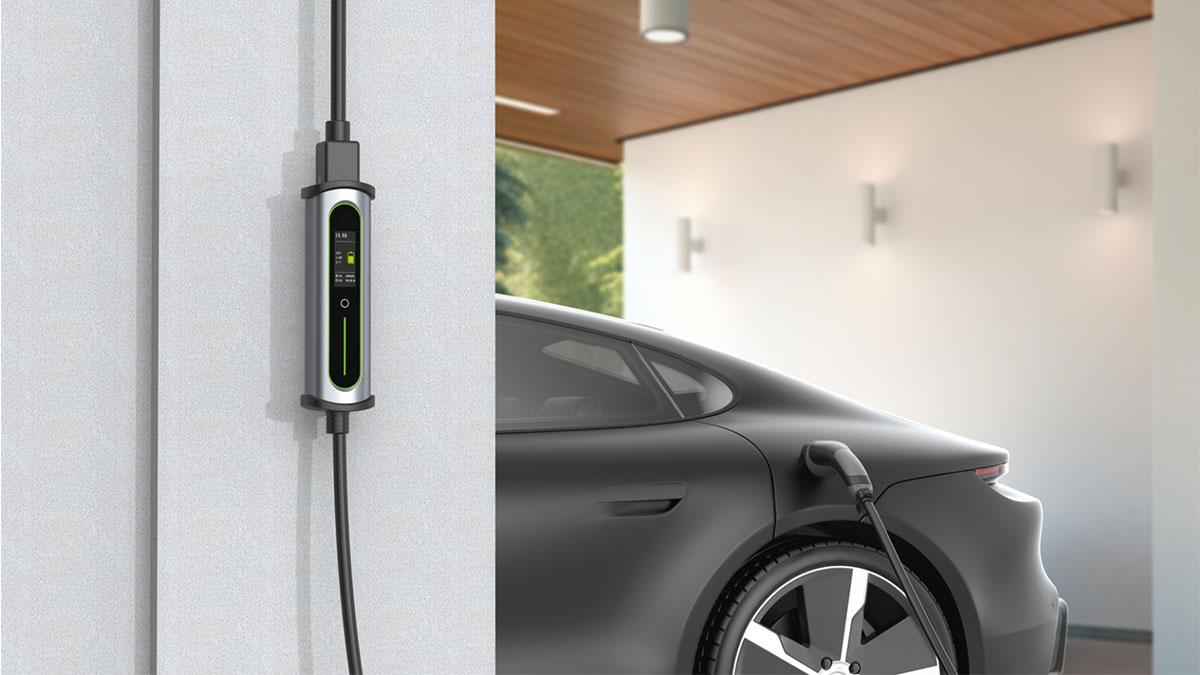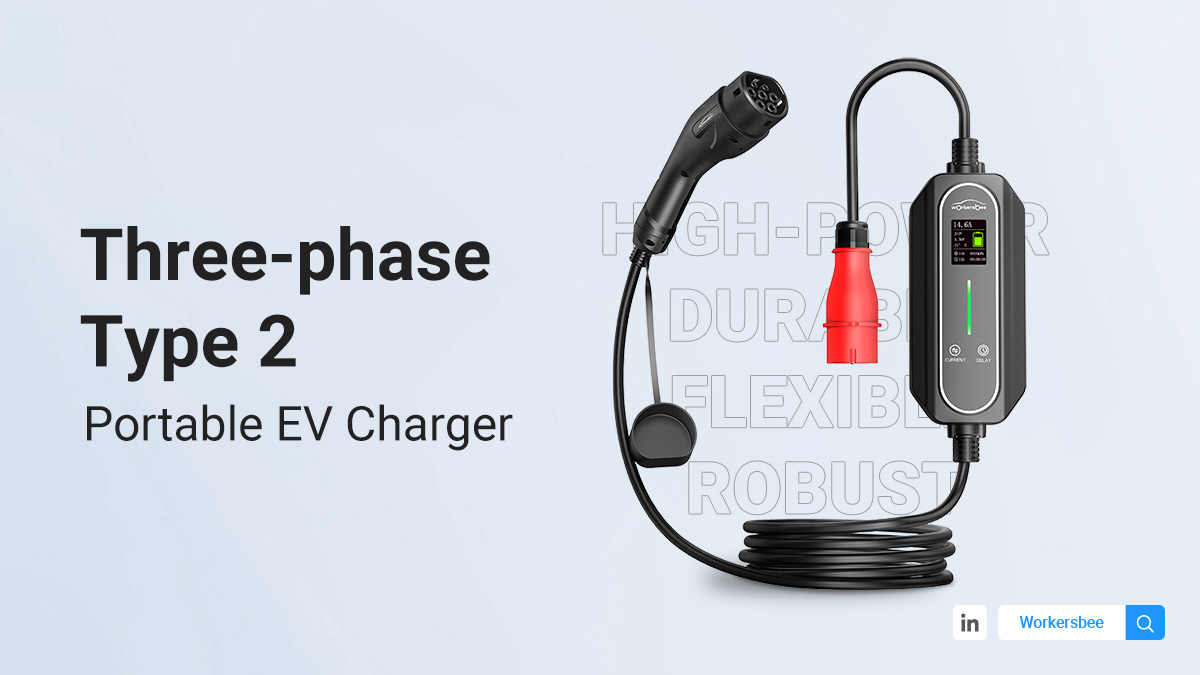 Dreiphasiges tragbares Laden zu Hause: Auswahl zwischen Workersbee Dura Charger und ePort C
Dreiphasiges tragbares Laden zu Hause: Auswahl zwischen Workersbee Dura Charger und ePort C
Aug 20, 2025
Das Laden zu Hause sollte mühelos sein. Wenn Ihr Haus oder Gebäude über Drehstrom verfügt, kann ein tragbares Mode-2-Ladegerät ohne feste Installation die Geschwindigkeit einer Wallbox liefern. Dieser Leitfaden erklärt, wann 11 kW oder 22 kW sinnvoll sind, wie der Mode-2-Schutz funktioniert und wie Sie zwischen dem Dura Charger von Workersbee und ePort C wählen. Warum dreiphasige tragbare Geräte sinnvoll sindWallbox-Geschwindigkeit, keine Installation erforderlich: In eine vorschriftsmäßig installierte rote CEE-Steckdose einstecken und 11 kW (3×16 A) bzw. 22 kW (3×32 A) erhalten.Tragbare Investition: Nehmen Sie es mit, wenn Sie umziehen, den Parkplatz wechseln oder an einem zweiten Standort aufladen müssen.Zukunftssicherheit: Auch wenn die Leistung heutiger Elektrofahrzeuge bei 11 kW Wechselstrom liegt, kann eine 22-kW-Einheit das nächste Fahrzeug oder den nächsten Besucher versorgen. 11 kW oder 22 kW – was für Sie das Richtige ist11 kW eignet sich zum Aufladen über Nacht, für Wohnungen mit begrenzter Versorgung und für Modelle, deren integrierte AC-Leistung maximal 11 kW beträgt.22 kW eignet sich hervorragend für größere Batterien, Haushalte mit mehreren Autos, die sich eine Steckdose teilen, oder für verspätete Rückgaben, die vor dem Morgengrauen schnell abgewickelt werden müssen.Denken Sie daran: Das Bordladegerät Ihres Elektrofahrzeugs legt die Obergrenze für die AC-Ladegeschwindigkeit fest. Funktionsweise der Mode 2-Sicherheit (einfache Version)Ein Mode-2-Ladegerät integriert Steuerung und Schutz in die Kabelbox. Es prüft die Stromversorgung vor dem Laden, überwacht die Temperatur und verfügt über einen Fehlerstrom-/Leckstromschutz, sodass das System bei Problemen sicher abgeschaltet wird. Achten Sie auf ein robustes Gehäuse (z. B. IP67) und klare Statusanzeigen. Lernen Sie die Produkte kennenWorkersbee Dura LadegerätEine flexible, tragbare Typ-2-Lösung, die sich an ein- oder dreiphasige Stromversorgung mit einstellbarer Stromstärke anpasst. Sie ist für Reisen und den täglichen Gebrauch zu Hause konzipiert, passt sich gut an unterschiedliche Standortbedingungen an und verfügt über Übertemperatur- und Leckageschutz in einem robusten Gehäuse. Workersbee ePort C (3-phasig, tragbar, Typ 2, 11/22 kW)Eine unkomplizierte, leistungsstarke Einheit mit Fokus auf leistungsstarkem Dreiphasenladen. Wählen Sie 16 A für bis zu 11 kW oder 32 A für bis zu 22 kW. Es verfügt über umfassende Schutzfunktionen (Überstrom, Über-/Unterspannung, Temperatur, Leckage) und eine robuste, für den Außenbereich geeignete Bauweise. Nebeneinanderstellung (was wirklich zählt) ArtikelDura-LadegerätePort CAC-PhasenEin- oder dreiphasigDreiphasigNennleistungBis zu 22 kW (fahrzeugabhängig)Bis zu 22 kW (wählbar 16/32 A)StromregelungAnpassbar, standortfreundlichZwei klare Modi: 16 A / 32 ASicherheitLeckage- + Übertemperatur- + VersorgungsprüfungenLeckage + Über-/Unterspannung + Überstrom + ÜbertemperaturSchutzartIP67-GehäuseIP67-GehäuseProfil verwendenMaximale Flexibilität, reisefertigEinfach, robust und für den Heimgebrauch geeignetAm besten geeignet fürStandorte mit gemischter Stromversorgung und häufige UmzügeSchneller Wechselstrom an einer festen Drehstromsteckdose Einrichtungsgrundlagen für EigenheimbesitzerBitten Sie einen zugelassenen Elektriker, die richtige rotes CEE Drehstromsteckdose: 16 A für 11 kW, 32 A für 22 kW.Überprüfen Sie die Panelkapazität und den entsprechenden Stromkreisschutz.Planen Sie die Kabelführung und einen trockenen Aufbewahrungsort ein; bringen Sie für den täglichen Komfort einen Haken oder eine Halterung in der Nähe der Steckdose an. Alltägliche AnwendungsmöglichkeitenEinfahrt oder Carport: Steuerbox aufhängen, beim Parken einstecken, nach Gebrauch locker aufrollen.Zugewiesener Garagenstellplatz: Reduzieren Sie den Strom, wenn das Gebäude Grenzen hat.Zweitwohnsitz oder Werkstatt: Nehmen Sie überall dort, wo es eine kompatible Steckdose gibt, eine Wechselstromsteckdose mit.Mehrwagenabende: Eine 22-kW-Steckdose ermöglicht Ihnen das sequenzielle Aufladen von Autos mit kürzeren Verweilzeiten. Pflege und KabelmanagementHalten Sie Stecker verschlossen, vermeiden Sie enge Wicklungen im warmen Zustand, spülen Sie den Straßenschmutz vom Kabel ab und bewahren Sie es in einem sauberen, trockenen Beutel auf. Diese kleinen Tipps schützen die Dichtungen und verlängern die Lebensdauer. Welches sollten Sie wählenWählen Dura-Ladegerät wenn Sie Wert auf die Anpassungsfähigkeit an verschiedene Standorte und Stromversorgungen legen oder erwarten, das Ladegerät häufig zu bewegen.Wählen ePort C wenn Sie hauptsächlich an einem Ort mit einer dreiphasigen Steckdose laden und den einfachsten Weg zum schnellen, zuverlässigen Aufladen mit Wechselstrom suchen. Häufig gestellte Fragen Benötige ich eine rote CEE-Steckdose? Welche Größe?Ja. Verwenden Sie einen dreiphasigen roten CEE-Stecker, der von einem zugelassenen Elektriker installiert wurde: 16 A (bis 11 kW) oder 32 A (bis zu 22 kW), abgestimmt auf entsprechende Leistungsschalter und Verkabelung. Wird ein 22-kW-Ladegerät ein auf 11 kW Wechselstrom begrenztes Elektrofahrzeug beschleunigen?Nein. Das Bordladegerät des Elektrofahrzeugs bestimmt den Wechselstromtarif. Bei zukünftigen Fahrzeugen oder der gemeinsamen Nutzung hilft weiterhin ein 22-kW-Gerät. Kann ePort C einphasig betrieben werden?ePort C ist speziell für dreiphasige Stromversorgung ausgelegt. Wenn Sie häufig zwischen ein- und dreiphasigen Standorten wechseln, Dura-Ladegerät passt besser. Ist das Laden im Freien bei Regen oder Schnee sicher?Beide Geräte verfügen über robuste, abgedichtete Gehäuse (IP67). Bei Nichtgebrauch die Kappen aufsetzen und die Anschlüsse nicht in stehendes Wasser tauchen. Kann ich den Ladestrom einstellen?Ja. Beide Produkte unterstützen die Stromanpassung, um die Standortgrenzen einzuhalten oder Fehlauslösungen zu vermeiden. Welches Zubehör ist eine Ergänzung wert?Ein Wandhaken, Anschlusskappen, eine Tragetasche und eine Aufbewahrungstasche. Wenn Sie andere Steckertypen oder Kabellängen benötigen, wenden Sie sich an Workersbee, um OEM/ODM-Optionen zu erhalten. Wie entscheide ich mich zwischen 11 kW und 22 kW?Passen Sie die Leistung an die AC-Grenze Ihres Elektrofahrzeugs und die Kapazität Ihres Standorts an. 11 kW deckt den Großteil des Nachtbedarfs ab; 22 kW eignen sich hervorragend für größere Batterien, gemeinsam genutzte Steckdosen oder schnelle Umschlagzeiten. Bereit für einfaches dreiphasiges Laden zu Hause? Kontaktieren Sie Workersbee für eine schnelle Kompatibilitätsprüfung und eine individuelle Empfehlung zwischen Dura Charger und ePort C. Fordern Sie ein Angebot oder Muster an oder fragen Sie nach OEM/ODM-Optionen für Branding, Kabellänge und Steckertypen.
MEHR LESEN

 Dreiphasiges tragbares Laden zu Hause: Auswahl zwischen Workersbee Dura Charger und ePort C
Dreiphasiges tragbares Laden zu Hause: Auswahl zwischen Workersbee Dura Charger und ePort C
 Bahnbrechend: Der Aufstieg dreiphasiger tragbarer Ladegeräte für Elektrofahrzeuge zum Laden zu Hause
Bahnbrechend: Der Aufstieg dreiphasiger tragbarer Ladegeräte für Elektrofahrzeuge zum Laden zu Hause